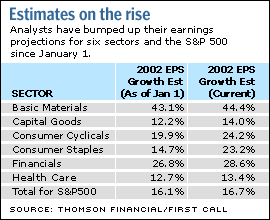
NEW YORK (CNN/Money) -
2002 began with the hopes that the stock market would finally rebound. After all, the Nasdaq had never declined three years in a row. And the last time the Dow and S&P 500 posted such a dubious hat trick was 1939-1941.
After one quarter, investors still don't have a huge amount to cheer about. The Dow is up 3.8 percent. But that's just 30 stocks. The S&P 500 finished the quarter relatively flat as did the average stock mutual fund. Technology stocks continue to really struggle. The Nasdaq is down more than 5 percent this year.
Still, there were some bright spots in the quarter...along with some real stinkers. So without further ado, here's a look at some of the best and worst performing stocks of the first quarter.
Simply the best
Top honors go to Crown Cork & Seal (CCK: Research, Estimates), a packaging company that doesn't seem to have a bright future but may have value in its numerous parts. The stock gained 252.3 percent in the quarter. Faced with a monstrous debt load and concerns about asbestos liabilities, the company has been busy selling off assets and unloading its fragrance pump and pharmaceutical packaging business this year. Now there is speculation that the company may be bought out by British packaging firm Rexam, which acquired Crown's fragrance pump business in January. Still, barring a takeover of Crown Cork & Seal, there doesn't look like there's much left for investors to feast on.

But some stocks did do well because of good fundamentals. Gold stocks surged in the first quarter thanks to strong demand, which helped keep the price of gold hovering around $300 for the better part of the year. Precious metals funds were the best performing mutual fund category for the first quarter, up a glistening 35.3 percent. Among the stocks, two South Africa-based miners, Gold Fields (GOLD: Research, Estimates) and Harmony Gold Mining (HGMCY: Research, Estimates) are the tops, increasing 117.5 percent and 74.9 percent respectively. (For more about gold stocks, click here.)
Several specialty retailers also did well as the economy continues to rebound. Shares of Jo-Ann Stores (JAS.A: Research, Estimates), which sells fabrics and crafts, were up 125.7 percent. Earnings for its fiscal fourth quarter (which ended on Feb. 2) soared 74 percent and the company reported a whopping 14.7 percent gain in same-store sales in February. Other retailers that gained at least 50 percent in the quarter were Whitehall Jewelers (JWL: Research, Estimates), discount chain ShopKo (SKO: Research, Estimates) and The Sports Authority (TSA: Research, Estimates).
Casino stocks also were solid performers as tourists returned to Las Vegas. Boyd Gaming (BYD: Research, Estimates) more than doubled while Hollywood Casino (HWD: Research, Estimates) was up 57 percent. (See Lady Luck has nice legs.)
And even some Internet stocks (remember them?) were big gainers. Online loan marketplace LendingTree (TREE: Research, Estimates) surged 127 percent thanks to a strong mortgage market. And United Online (UNTD: Research, Estimates), the company formed from the merger of Internet service providers Juno and NetZero, gained 104.8 percent.
Telecom is a big loser
Looking at the losers, it was easier to spot a trend. Telecom is still in a major world of hurt. Wireless carriers and telecom equipment companies were particularly woeful performers. Ten wireless carriers have lost more than half their value this year and four of those ranked among the ten biggest losers.

The losers ranged from national carriers like Sprint PCS (PCS: Research, Estimates) and Nextel (NXTL: Research, Estimates) to smaller regional affiliates such as Airgate PCS (PCSA: Research, Estimates) and Western Wireless (WWCA: Research, Estimates).
Greg Gorbatenko, an analyst with Loop Capital says the combination of slowing subscriber growth and higher costs to upgrade to newer networks were the two major culprits behind the sector's collapse.
The telecom equipment sector is still a mess as carriers continue to hold back on spending. British networking firm Marconi (MONI: Research, Estimates) was the quarter's worst performer, dropping more than 80 percent, as fears of an imminent bankruptcy have begun to mount. Riverstone Networks (RSTN: Research, Estimates), Acterna (ACTR: Research, Estimates) andCorvis (CORV: Research, Estimates) were other big telecom equipment losers. Each fell at least 60 percent in the quarter.
Kmart (KM: Research, Estimates) was one of the few retailers to post a dismal first quarter. The bankrupt discount retailer plunged 70.7 percent. Accounting concerns dogged several losing stocks as well, most notably Irish pharmaceutical firm Elan (ELN: Research, Estimates), which fell nearly 70 percent. And biotechs continued to be a volatile sector. Sepracor (SEPR: Research, Estimates) and Corixa (CRXA: Research, Estimates) both lost more than half their value in the first quarter following unfavorable news from the Food and Drug Administration regarding their allergy and lymphoma drugs respectively. (For a look at less risky biotech investments, click here.)
What's next?
So what's ahead for the second quarter and beyond? Probably much of the same. Basic materials, including gold, should continue to perform well. Earnings for the year are expected to increase by more than 40 percent. And consumer cyclicals like retail will likely benefit from the economy's renewed strength. Financials, another sector that tends to do well in the initial stages of a recovery, should also experience healthy levels of growth even if interest rates continue to rise. (Click here for some financial fund managers' picks.)

Expectations for the technology sector are high, particularly for the second half of the year. Analysts are predicting that earnings will more than double in the third quarter and increase by more than 70 percent in the fourth quarter. That's because the tech sector will be facing relatively easy comparisons since the second half of last year was so dismal.
But the jury is still out on whether or not these estimates are too optimistic. While there are more signs of increasing demand in the semiconductor sector, it's looking like a telecom recovery won't take place until 2003 at the earliest.

|

